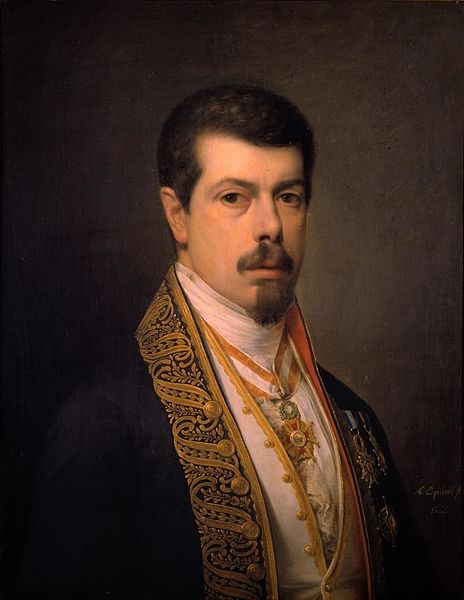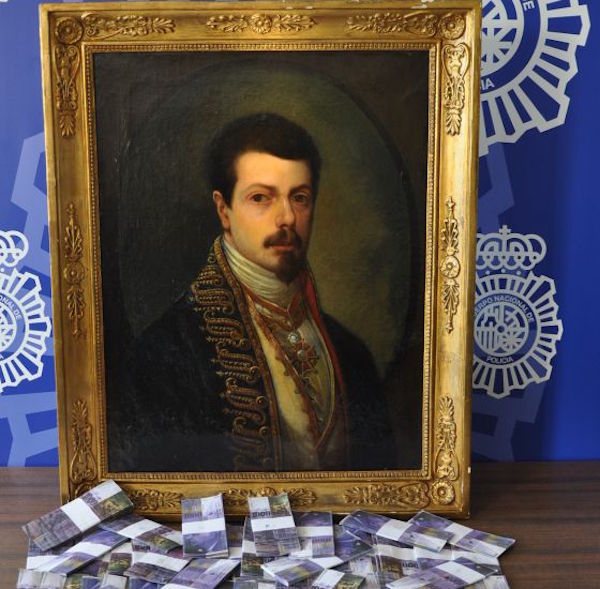An Unreal Art Caper

The painting pictured above, as descrbied on Wikipedia, is a self-portrait of and by a 19th century Spanish artist named Antonio María Esquivel. Per other accounts, though, Esquivel didn’t create the picture — it was one of the many works by a much more famous Spanish artist, Francisco Goya, who is known most often simply as Goya. Those reports are probably wrong — when Goya died in 1828, Esquivel was a barely 22-year-old nobody; and if you look closely, you’ll see that Esquivel signed the work.
But if you were a scammer back in the day, and you were hoping to sell the painting above, you’d talk it up as if it were by Goya. And that’s mostly waht happened in 2003; that year, two Catalan brothers bought the painting aboveor €270,000, convinced that they were getting a legit Goya.
They weren’t, which is bad. But it gets worse.
They weren’t even getting a legit Esquivel.
The brothers thought they were buying the painting above — but they didn’t. In fact, they bought the painting below instead. (For the time being, ignore the piles of money. We’ll get there.) The paintings have some pretty obvious differences, at least when viewed at the same time — the hair sis different, the colors more muted, the frilly thing around his neck isn’t nearly as ornate, etc. But without the benefit of side-by-side compariosn, you could see how one would be mistaken. We can forgive the two brothers for not noticing at first.

Ultimately, though, the brothers figured out that they were the victim of a ruse, and did so early enough where they were able to get out of the deal with only a €20,000 loss (the deposit they put down). They were allowed to retain the painting as part of the now-aborted deal, too. It was likely worthless, of course — again, it wasn’t by Goya, so it wasn’t worth a lot to begin with, and even then, it was a forgery. The brothers really had no need to keep the painting — unless they could find another sucker who thought it was a real Goya.
And that is exactly what they tried to do.
It’s not so easy to sell an expensive piece of legitimate art, let alone one with dubious credentials and being sold by someone without much of a reputation in the art dealing world. Even in the best of cases, you need to find someone with a lot of money, and that can be hard to do. But thankfully for the brothers, they were somehow put in contact with a character that the Independent called “a mysterious Italian middleman.” And not having the value of hindsight, they didn’t see the inherent dangers of working with someone who would later be described as a mysterious middleman.
The middleman’s contact on the other end was an Arab sheikh, awash in more money than he could ever spend on practical items. But a one-of-a-kind painting by Goya is hardly a practical item, so there was a match. The sheikh agreed to a price of €4 million, payable in equivalent Swiss francs, and over a few installments. The only catch was that the middleman demanded a €300,000 premium from the sellers the day before the first payment came due — he, apparently, wasn’t being paid by the sheikh (or perhaps was playing both sides). Regardless, the brothers borrowed €300,000 from a friend, and, the next day, traveled to Turin, Italy, to collect the first payment for the painting. According to ArtNet, the middleman delivered the first payment — the equivalent €1.5 million, in the form of 1.7 million Swiss francs — as promised. It looked like the sheikh was out a lot of money.
But he wasn’t. The brothers left Italy and went to Geneva, Switzerland, to deposit their newfound riches — only to find out that the Swiss francs weren’t legal tender. They were photocopies. The image above, with the counterfeit painting? The money pictured is counterfeit, too. The sheikh had paid for a fake Goya with fake cash.
The brothers left Geneva with their fake money and traveled to France, where customs officials found the counterfeit currency and notified Spanish authorities. The two brothers — now out €320,000 with nothing but a pile of garbage to show for it — were also now in legal trouble. They were subsequently arrested in Spain for fraud; they were trying to sell a fake Goya, after all.
The middleman (and sheikh, if he existed) didn’t suffer the same fate — he made off with the €300,000.
Bonus Fact: In 1814, Goya painted an oil on canvas called “The Third of May, 1808,” which per Wikipedia, “sought to commemorate Spanish resistance to Napoleon’s armies.” The painting, seen here, features a man standing in front of a firing squad with his arms stretched wide. That person’s pose is, kind of, the inspiration behind the peace symbol. Per another Wikipedia entry, the artist, Gerard Holtom referred to the Third of May “as one of his inspirations for the peace sign,” but must not have looked at Goya’s painting again when drawing the now well-known symbol. As Holtom remembered it, the man before the firing squad had his arms “outstretched outwards and downwards,” but in the actual painting, his arms clearly point upward.
From the Archives: The Moneymaker: His fakes weren’t photocopies.
Take the Quiz: Name the one-syllable words that rhyme with “art.”
Related: $50,000, useful only if purchasing a fake non-Goya (or if you’re making a movie).
